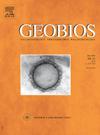First record of Chelonian coprolites from the Early-Middle Miocene Kutch Basin, western India, and their palaeodietary and palaeobiological implications
Abstract
In this paper, we provide the first data on large (cm-sized) coprolites (represented by three morphotypes) comprising a rare occurrence of eight specimens from a total of three vertebrate-bearing horizons identified within the Early Miocene (Aquitanian) Khari Nadi Formation and Middle Miocene (Burdigalian-Langhian) Chassra Formation, Kutch Basin, western India. The geochemical data confirm the phosphatic character of the investigated ichnofossils. The dominance of partly digested bone matter and presence of plant remains in all the three coprolite morphotypes reflects the omnivorous diet of the producers, which were most likely chelonians. The occurrence of an inclusion (in a coprolite specimen recorded in this study) showcasing an ultrastructure similar to mammalian dental enamel is a rarity in Neogene coprolite records. Additional biotic inclusions observed in the investigated coprolites include ostracods (assigned to genera Paractinocythereis, Hermanites, and Propontocypris); large planispiral benthic foraminifera including the genus Quinqueloculina; uniserial and biserial benthic foraminifera belonging to genus Textularia; marine calcareous algae genus Actinoporella; chrysophytes (resting spores or cysts of planktonic algae); sponge spicules (represented by the morphotypes Acanthoxea and Strongyle); freshwater diatom genus Aulacoseira; unidentified fungal remains; and phytoliths. Taken together, the biotic and abiotic (e.g., pyrite) inclusions, geochemical data and associated microbiota suggest that these ichnofossils were deposited in a dominantly coastal marine (intertidal) setting linked to a lacustrine/palustrine environment.

 求助内容:
求助内容: 应助结果提醒方式:
应助结果提醒方式:


